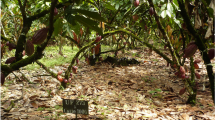Abstract
Although forestry residuals provide a potentially abundant source of biomass, Douglas fir is a particularly challenging feedstock to utilize in the biochemical conversion to fuels and value-added chemicals due to its high levels of biomass recalcitrance. A greater understanding of the underlying factors behind highly recalcitrant biomass is critical in overcoming this problem. Building on earlier efforts to establish a protocol and a “recalcitrance factor” for screening the recalcitrance of trees, this study attempts to provide the first look into the genetic factors behind recalcitrance in Douglas fir with the possibility of using selective breeding and tree improvement practices to reduce recalcitrance in future generations of our forest products. Samples from over 250 Douglas fir trees in a second-cycle progeny test were collected and subjected to screening. Samples were subjected to a dilute-acid pretreatment and a subsequent enzymatic hydrolysis procedure, ultimately measuring the raw wood density, pretreatment yield, the holocellulose content of pretreated samples, hydrolyzability, and recalcitrance factor. From these data, the heritability, genetic gains, and genetic correlations were estimated. Based on these results, we predict that modifying recalcitrance in tree improvement may be feasible, but would likely require some additional understanding and improved screening techniques.



Similar content being viewed by others
References
Wyman CE (2007) What is (and is not) vital to advancing cellulosic ethanol. Trends Biotechnol 25:153–157
McCann, M. C., and N. C. Carpita (2015) Biomass recalcitrance: a multi-scale, multi-factor, and conversion-specific property. Journal of Experimental Botany. 66:4109–4118
Mabee WE, Gregg DJ, Arato C, Berlin A, Bura R, Gilkes N, Mirochnik O, Pan XJ, Pye EK, Saddler JN (2006) Updates on softwood-to-ethanol process development. Appl Biochem Biotechnol 129:55–70
Phitsuwan P, Sakka K, Ratanakhanokchai K (2013) Improvement of lignocellulosic biomassin planta: a review of feedstocks, biomass recalcitrance, and strategic manipulation of ideal plants designed for ethanol production and processability. Biomass Bioenergy 58:15
White TL, Adams WT, Neale DB (2007) Forest genetics. CAB International, Cambridge, Massachusetts
Howe GT, Jayawickrama K, Cherry M, Johnson GR, Wheeler NC (2006) Breeding Douglas-fir. In: Janick J (ed) Plant breeding reviews, vol. 27. Wiley-Blackwell, MA, USA, pp 245–353
Zobel, B. J., and J. P. Van Buijtenen (1989) Wood variation: its causes and control. Springer-Verlag, Berlin
Bouton JH (2007) Molecular breeding of switchgrass for use as a biofuel crop. Curr Opin Genetics Dev 17:553–558
Geleynse S, Alvarez-Vasco C, Garcia K, Jayawickrama K, Trappe M, Zhang X (2014) A multi-level analysis approach to measuring variations in biomass recalcitrance of Douglas fir tree samples. Bioenergy Res 7:1411–1420
Ukrainetz NK, Kang KY, Aitken SN, Stoehr M, Mansfield SD (2008) Heritability and phenotypic and genetic correlations of coastal Douglas-fir (Pseudotsuga menziesii) wood quality traits. Canadian J Forest Res-Revue Canadienne De Recherche Forestiere 38:1536–1546
Mosier N, Wyman C, Dale B, Elander R, Lee YY, Holtzapple M, Ladisch M (2005) Features of promising technologies for pretreatment of lignocellulosic biomass. Bioresour Technol 96:673–686
Wise LE, Murphy M, D’Addieco AA (1946) Chlorite holocellulose, its fractionation and bearing on summative wood analysis and on studies on the hemicelluloses. Paper Tr J 122:35–43
Timell TE (1959) Isolation of holocellulose from Jack pine Pinus banksiana. Pulp Paper Mag Can 60:T26–T28
Gilmour, A.R., Gogel, B.J., Cullis, B.R., and Thompson, R. 2009 ASReml User Guide Release 3.0 VSN International Ltd, Hemel Hempstead, HP1 1ES, UK www.vsni.co.uk
Lynch M, Walsh B (1998) Genetics and analysis of quantitative traits. Sinauer Associates, Inc., Sunderland, Massachusetts
Falconer, D. S., and T. F. C. Mackay (1996) Introduction to quantitative genetics. Longman, New York
Henderson CR (1984) Applications of linear models in animal breeding. University of Guelph, Guelph, Ontario
Zobel, B. J., and J. B. Jett (1995) Genetics of wood production. Springer-Verlag, Berlin
Foston M, Ragauskas AJ (2012) Biomass characterization: recent progress in understanding biomass recalcitrance. Ind Biotechnol 8:191–208
Howe GT, Yu JB, Knaus B, Cronn R, Kolpak S, Dolan P, Lorenz WW, Dean JFD (2013) A SNP resource for Douglas-fir: de novo transcriptome assembly and SNP detection and validation. BMC Genomics 14:137–158
Acknowledgments
Funding for this study is provided through the Northwest Advanced Renewables Alliance Project, supported by an Agriculture and Food Research Initiative Competitive Grant No. 2011-68005-30416 from the USDA National Institute of Food and Agriculture. This study is also supported, in part, by National Science Foundation (award number 1067012). Permission provided by Plum Creek Timber Company and Campbell Global to access the test site and obtain samples is also acknowledged.
Author information
Authors and Affiliations
Corresponding author
Electronic supplementary materials
Below is the link to the electronic supplementary material.
ESM 1
(DOCX 76 kb)
Rights and permissions
About this article
Cite this article
Geleynse, S., Jayawickrama, K., Trappe, M. et al. Genetic Parameters of Factors Affecting the Biomass Recalcitrance of Douglas Fir Trees. Bioenerg. Res. 9, 731–739 (2016). https://doi.org/10.1007/s12155-016-9718-2
Published:
Issue Date:
DOI: https://doi.org/10.1007/s12155-016-9718-2




